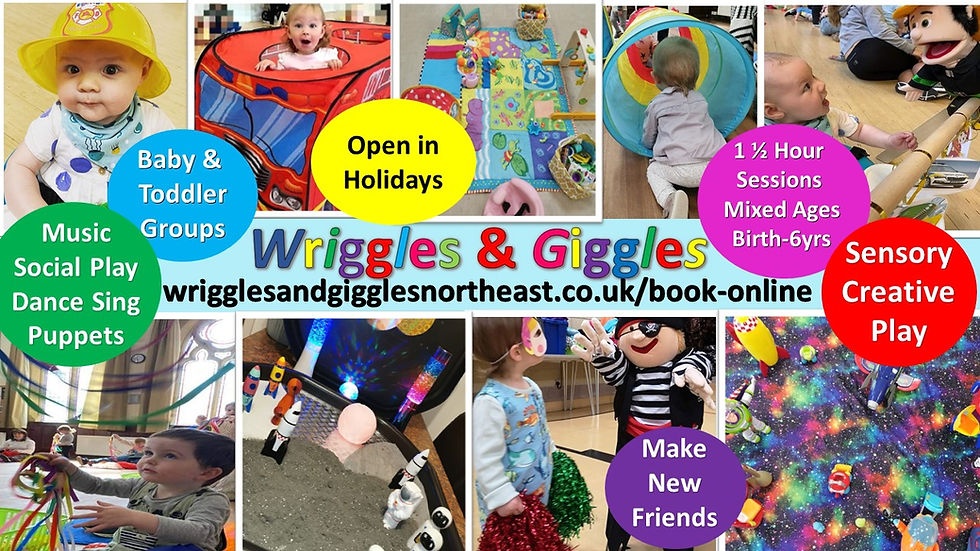Why vehicles Excite me!!
- Wriggles & Giggles

- May 4, 2022
- 3 min read
Updated: Jul 5, 2024
So what's the big deal about cars, trucks, trains, and buses?

From age 0-2, children are in the sensorimotor stage of development. They are learning by absorbing everything through their senses — sight, touch, taste, smell, hear. Toys and real-life objects like cars are very sensorily engaging. Early years can interact with toy cars, trucks, etc. through spinning their wheels, watching them move in a variety of directions, or hearing the sounds they make.
Early years are just naturally drawn to loud, moving objects — it's all fun sensory input. They see the lights on the cars, the rolling wheels, the sound of the revving engine and it's very engaging. Children will always be drawn to flashy and loud things because that is what engages their brain and sensory systems.
Another appeal of toy vehicles is that they're typically small enough to fit in a child's hand. Cars become the favourite of both boys and girls because they're the kind of toy that they can take — and play with — anywhere. They can pop their cars in their pocket or carry them around, they're easy to get attached to.

A car is also a cause-and-effect toy — it teaches children that their actions can make something happen. It's super interesting and exciting for children to learn that they can change something in their environment. With cars, children can work out all kinds of fun scenarios like going up the wall or having a crash.
The benefits of toy cars are numerous, then. Experts agree they should be part of both boys' and girls' play environments.
The toy car is an inexpensive, accessible toy that promotes learning, environmental exploration, independence, motor skills, problem-solving, and creativity, and above all, they're fun. There's nothing like hearing a child work through a crash scenario with all the sounds and listening to how when one road closes, they find another or watching the thrill as the car goes up a wall to avoid a monster.

At Wriggles and Giggles we run 1 1/5 hour group sessions with lots of activities to explore using music, movement, puppets, lights, sensory creative and social play. We offer many opportunities for vehicle play which include other materials and early years playing together. You can book onto a group session in Yarm, Hartburn & Thornaby and we are open every week including holidays. See our Book tab on this website for more details.

While every toy car has the same basic parts, how your child plays with it depends on their unique characteristics, and nobody knows exactly what is at the root of a child’s individual play style. For instance, one child might drive their cars into the wall, another might line them up, bumper to bumper, and another might wrap them in a blanket.

Every child is unique in how they engage with toys, and the reasons for their play style may be diverse and complex. However, children often interact with materials in similar ways to how their families interact with them. If a child sees a sibling or parents modelling play with a car going fast down a track, they are likely going to interact with the toy that same way.
Some children seek sensory engagement from their toys in different ways. The feel and sound of crashing cars might be interesting to them, or they may like organisation and neatness so lining their toys up in a certain way may bring them calm.
Ultimately, how your child plays with their toy vehicles could be a little window into what regulates or excites them.

Wheel Spinning !!
Children often see wheels and that they spin and want to explore it further. Early years are all about finding out how things work and how to live in this big world.
Wheels are fun because they spin but don’t move. You may find that your baby or toddler flips over every car they own just to turn the wheels.
This is pretty common and not necessarily a sign for concern. Think of all the places that your toddler may experience wheel spinning, from watching a car drive by watching the wheels on their favourite toy spin.
All of these environmental factors lead a child to be interested in exploring.
There's really no discouraging it, so it's best to embrace your toddler's interests as a part of their learning process, which is exactly what researchers say it is. The act of observing things rolling, whether on a track or on a road in the case of cars has been shown to improve spatial awareness and can eventually lead to better outcomes in STEM learning.
Children and adults well beyond their toddler years, still cling to that love as though it were a security blanket.





Comments